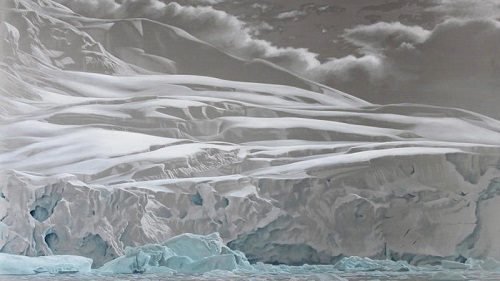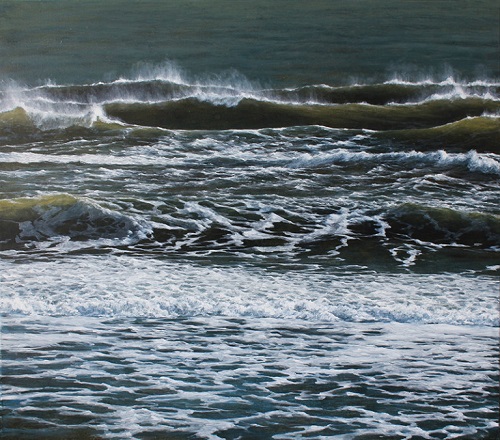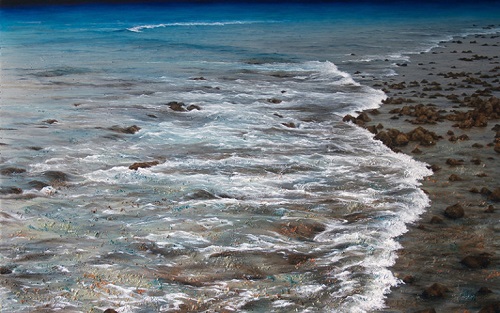
Lisa Lebofsky, Petzval Glacier, 2011, oil paint on aluminum, 40x64 inches, ©Lisa Lebofsky
Previously on display in Environmental Impact
The human relationship with nature is complex. We strive to find ways to protect ourselves from its humbling power, yet we yearn to surround ourselves with it. Nature is a respite from our technologically burdened lives – from beach oases to soaring mountaintop vistas. We enjoy its bounty of shorelines and woodlands, create havens in parks and personal gardens, and take countless photos of sunsets and waterfalls. At the same time, we pollute it, burn it, defile it, and eradicate it. Through action or inaction, we are all complicit in some way.
Art serves many purposes, but one of the most important is that it enables a person to lay her eyes upon something and be moved – moved to make art of her own, moved to make changes in life, moved to relate to an occurrence, act on it, learn from it, and feel better because of it. That is the key word: feel. Art is feeling. It is a familiarity, a comfort. Out there is a person unknown to you creating an experience you can relate to, and that others can relate to as well. There are billions of people who face the same angst and fears we all face. We may have our unique experiences that bring us to an emotion, but in the end, we all have the same spectrum of feeling. Art tells stories, inspires, and provides a reprieve – taking us out of our heads to view something outside of ourselves that removes anguish, and reminds us that we are not alone. Art generates awareness. We care about that with which we are aware; which in turn, inspires us to be better.
Experiencing nature is similar to experiencing art. Nature is inspiration and transcendence. It is a place of solitude that offers simplicity, peace, and a means for us to stretch our physical and mental space to fill our bodies and souls with air. For centuries, humans have returned to nature to find clarity and comfort. Because of this grand gesture, and given the significance it bestows, we should cherish nature in the same way it nurtures us.
I endeavor to experience nature in a personal way as often and as profoundly as I can. It has always called for and moved me, stemming from a childhood spent exploring the woods surrounding my home, and my early experiences of painting outdoors and exploring Taoist philosophy. My history with and reverence for nature is mirrored through my current paintings of endangered landscapes.

Lisa Lebofsky, Crashing Waves – Montauk, 2016, oil paint on canvas, 40×42 inches, ©Lisa Lebofsky
I paint on surfaces that remain visible and permeate the entire image, guiding the viewer through various layers of paint. When I use an aluminum surface, the image becomes obliterated when light reflects off of it when viewed from certain positions. On canvas, I begin with a dark and murky underpainting – often created using elements from nature such as raindrops – that influence the softly painted upper layers of the piece. The push and pull of lights and darks, opacity and transparency, abstract and real, mirrors our complex relationship with nature.
By painting our depleting planet in this dichotomous manner, nature also becomes a metaphor for our very human fragility, and our emotional struggles and encounters. Interactions with nature reflect human experiences: how we feel, how we hurt the ones we love, our guilt, our passion, our adoration, our yearnings, our joy, our rationalizations, our grief, our layered relationships. In humanizing the story of climate change by revealing nature’s vulnerabilities as our own, it is my intention for my audience to be moved to respond personally and proactively.
I travel the globe in search of regions that are susceptible to climate change. Examples include Greenland, where the melting ice sheet is plain to any observer, and The Maldives, which will soon be forever changed and likely extinguished by rising seas. I immerse myself in these environments to develop my own deep connection to a place that I can thereafter share through my artwork.

Lisa Lebofsky, Polluted Surf – Maldives, 2015, oil paint and plastic on aluminum, 25×40 inches, ©Lisa Lebofsky
My paintings bear witness and memorialize places before they disappear, with goals to increase awareness of our changing planet, and inspire through appreciation of the natural world a more responsible and proactive stewardship. I hope that those who see my paintings of melting icebergs and glaciers are awoken to the horrific effects of the warming climate for which we are undoubtedly responsible. Perhaps some will be motivated to do what they can to help in an activist sense, or at least make helpful changes in their personal lives. Or, by providing my audience a window into the vulnerable eroding shorelines of low-lying nations, they begin to care enough to become more educated and participatory in the preservation of our planet.
Art that celebrates nature is understood and appreciated by people from different cultures and who speak different languages – the same kind of person who enjoys a peaceful sunset in the west, enjoys a majestic sunrise in the east. Artists who care about the environment, or who create work that has a connection with our natural surroundings, can do their part to bring people together, connect them through universally understood mediums of art, and help foster appreciation, consideration, and ultimately meaningful care for our planet.
ABOUT THE AUTHOR
Lisa Lebofsky is a New York based painter. She holds a BFA in metalsmithing from SUNY New Paltz, and an MFA in painting from New York Academy of Art. Her work is in private collections, and has been exhibited in solo and group shows both nationally and internationally. She is the recipient of several awards and residencies including the Prince of Wales travel grant to Château de Balleroy, France (2005), Terra Nova National Park, Newfoundland artist in residence (2010), the BRIO Grant from the Bronx Council of the Arts (2010, 2014), New Bedford Whaling Museum artist in residence (2013), and Saltonstall Foundation, artist in residence (2014). Her latest solo exhibition “Rip Current” (2015) began as an examination of how climate change is affecting the vulnerable shorelines of Long Island, New York within the greater global conversation; but became an emotional exploration in loss, struggle and adjustment. Recent travels include Antarctica, Newfoundland and Labrador, Greenland, and The Maldives.
|
|Back to Title|
Page 1
Page 2
Page 3
Page 4
Page 5
Page 6
Page 7
Page 8
Page 9
Supplement 1
Supplement 2
Supplement 3
Supplement 4
Supplement 5
Supplement 6
PelicanWeb Home Page
|